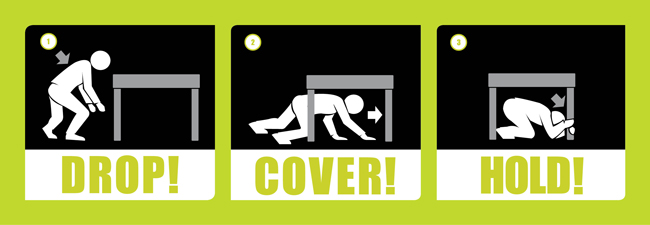South Australia can experience damaging and deadly earthquakes so make sure you know what to do before, during and after one.
Go to the Geoscience Australia Earthquakes@GA website:
- to find recent earthquakes
- to report an earthquake - click on the 'Felt Report' link at the top right of the map.
Before an earthquake
Do a walk-through of your home or business to locate safe places to DROP, COVER, HOLD:
- look for strong tables or desks that can provide shelter from falling debris
- look for places next to an interior wall away from:
- windows that can shatter
- tall furniture and hanging objects that can tip, fall or drop on you
- fire places with chimneys that can topple over and fall through the roof.
Fix potential hazards in your home or business:
- install latches on cupboards
- secure top-heavy furniture and appliances to walls
- keep wall and ceiling fixtures away from where you sleep or sit
- strap water heaters correctly to the wall
- store flammable or hazardous materials on lower shelves or on the floor
- store heavy or fragile items on bottom shelves.
Get qualified advice to make sure your home complies with the Building Code of Australia and fix any potential weaknesses.
Make sure your insurance covers you for earthquakes.
During an earthquake
In an earthquake it's important that you quickly DROP, COVER and HOLD.
DROP to the ground close to you - no more than a few steps or less than two metres away - where you can avoid injury from falling debris.
Take COVER under something strong, like a sturdy table.
HOLD on to it until the shaking stops.

If you are indoors
DROP, COVER AND HOLD.
If indoors, stay there. Wait until the shaking stops and you're sure it's safe to exit.
Important tips:
- If there isn't a table near you, drop down next to an interior wall and anything stable, cover your head and neck with your arms, hold onto the stable item or brace yourself against the wall.
- Don't run outside or to other rooms.
- Keep in mind that in modern homes, doorways are stronger than any other part of the house but doors can swing and injure you.
- Don't use escalators or lifts.
- Stay away from exterior walls, windows, chimneys and anything near you that could fall.
If you're in a crowded area, don't rush for the doors, move clear of overhead fittings and shelves and DROP, COVER and HOLD.
If you're in a lift, DROP, COVER and HOLD. When the shaking stops and it's safe to do so, try to get out at the nearest floor.
If you are outdoors
Move no more than a few steps, away from buildings, trees, streetlights, and powerlines. Then DROP, COVER and HOLD.
Stay outside until the shaking stops and you're sure it's safe to move about.
If you're in a city street, DROP, COVER and HOLD sheltering from falling debris under strong archways or doorways. Don't go under awnings or parapets as they might collapse.
If you're at the beach, DROP, COVER and HOLD. Move immediately to higher ground when the shaking stops.
If you are trapped under debris
Don't move about or kick up dust.
Cover your mouth with a handkerchief or clothing.
Tap on a pipe or wall so rescuers can locate you. Shout only as a last resort so you don't inhale dangerous amounts of dust.
If you are in a moving vehicle
If you are in a vehicle:
- pull over to an open area
- stop as quickly as safety permits
- stay in the vehicle, with your seatbelt on, until the shaking stops.
Avoid stopping near or under buildings, overpasses, and utility wires.
Check your local ABC radio station for warnings before moving.
Proceed cautiously once the earthquake has stopped and avoid roads, bridge ramps, or fallen powerlines that may have been damaged by the earthquake.
After an earthquake
Expect aftershocks. Each time DROP, COVER and HOLD.
Check for injuries:
- if someone is bleeding put direct pressure on the wound - use gauze or cloth
- don't move a seriously injured person unless they're in immediate danger
- for life-threatening injuries call Triple Zero (000).
First aid facts - St John Ambulance
Check for damage:
- if the building is severely damaged, get out straight away
- if possible put out small fires
- if you smell gas or hear a blowing or hissing noise:
- open windows
- get everyone outside
- don't use any electrical appliances as they create a spark
- turn off the gas at the meter or bottle
- if there is electrical damage turn the power off at the mains
- call a qualified electrician or gas fitter to fix faults before turning the gas or power back on
- cover spilt hazardous materials with dirt or absorbent material
- stay away from brick walls and chimneys with visible cracks
- stay away from downed powerlines and objects in contact with them.
When it's safe:
- help others, including neighbours
- tune into your local ABC radio station. Information may change quickly so check regularly for updates and heed any warnings
- don't overload phone lines with non-emergency calls. If you must use your mobile phone send text messages rather than calling
- don't drive unless it's an emergency
- be prepared for electricity, gas, phone and water outages
- report your earthquake experience to Geoscience Australia using the Felt Report (at the top right corner of the map).
Related information
- Facts about earthquakes - Geoscience Australia
- Tsunami warnings - Bureau of Meteorology (BOM)

